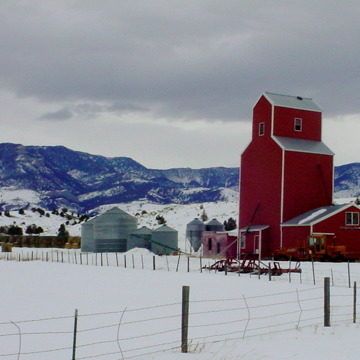Montana’s expansive Gallatin Valley became known to overland travelers during the gold rushes of the 1860s. As farmers settled in the western end of the valley to provision miners in the nearby gold camps at Bannack and Virginia City, the Gallatin emerged as the breadbasket of Montana. The arrival of the transcontinental railroads led to expanded agriculture, and the fertile valley soon led Montana in wheat, barley, and alfalfa production, along with dairying.
Following completion of the Chicago, Milwaukee and St. Paul Railroad in 1909, the “Milwaukee Road,” as it was known, expanded into the countryside with a network of branch lines and small townsites. In spring of 1913 the Milwaukee Road placed an ad for town lots to be offered at public auction, announcing the “Opening of 20 New Towns in Montana.” The 6-block townsite of Menard, tucked away in the hills northwest of the growing city of Bozeman was one of the twenty opened for settlement that year. With a railroad depot, general store, post office, school, dance hall, blacksmith shop, grain elevator, and railroad crew house, Menard served the needs of roughly 50 farm and ranch families during the homestead era and beyond.
The steam train that ran along this Bozeman–Menard branch line became known as the Turkey Red Special after the hard red wheat grown in the area. There were 13 stops along the line, named for farm families along the route. Milk, eggs, and cream were picked up from local farms, and shipments of wheat, barley, and oats were made from three identical grain elevators on the line, at Menard, Accola, and Spring Hill.
The Menard Elevator is a towering gable-roofed wooden structure that holds up to 18,000 bushels of wheat and grain in 6 side bins and 5 overhead bins, with an attached office, warehouse, and scale shed. Stout walls were constructed of cribbed 2 x 8 boards to bear the load of the grain within. On the ground level, the drive shed contains 8-ton scales at the center with 3-inch plank flooring to provide access for wagons and trucks to weigh in with their loads. Historically, the building was covered with lapped wood siding painted the signature dark red of the Montana Flour Mills Company, with the name Menard painted on the elevator tower.
These elevators operated under the Bozeman Milling Company through the 1910s, and during the 1920s–1960s they were owned by the Montana Flour Mills Company based in Lewistown. Engineer and builder V.R. McKerlie, who oversaw the design and construction of numerous elevators throughout Montana and for the Montana Flour Mills Company, is credited with design of the Menard elevator.
Montana Flour Mills Company ran boxcars out to Menard, the terminus of the Turkey Red Line, each fall at harvest time, when wheat was ready to ship. In the 1960s, Con Agra purchased the Montana Flour Mills Company, and in turn, sold the elevators to the local farmers. Frank DeHaan purchased the Menard elevator, and operated it until the Milwaukee abandoned the line in 1973. To this day, the elevator continues to be used by the DeHaan family’s ongoing farm and ranch operation, for storing wheat that they transport to nearby Belgrade by truck.
Wooden grain elevators were once a common sight across the Great Plains of North America, the centerpiece of agricultural towns throughout the United States and Canada. Changing technologies have rendered these magnificent prairie structures obsolete, and they are rapidly disappearing. Those that remain, and have been adopted by local communities for use or for interpretation, stand as lasting symbols of the homesteading movement and a connection for rural communities to their agricultural history.
References
Jiusto, Chere. “Montana Historical and Architectural Inventory Form for the Turkey Red Railroad Historic District, Gallatin County, Montana.” Montana State Historic Preservation Office, Helena, Montana, 2006.

